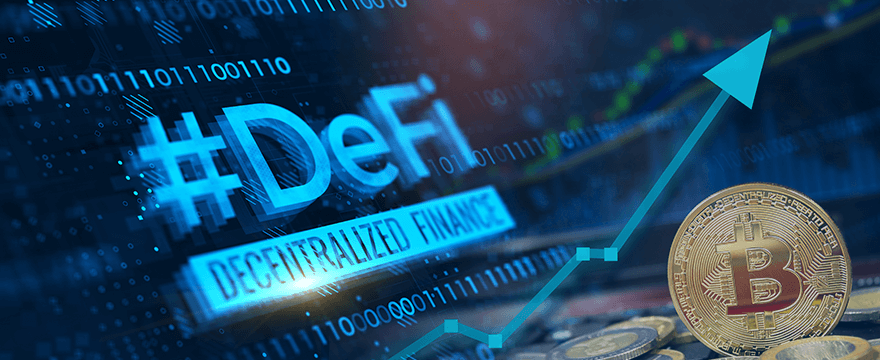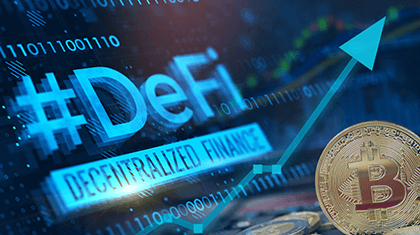
Regulation for FX/CFD Brokers – Part 2
December 9, 2020
Top Marketing Tips for FX Brokers
December 24, 2020
They say a year in crypto is like 10 years in traditional finance. So, if the last time you paid any proper attention to the crypto space was back in 2017, then you’re probably quite a bit out of date by now. Many of you will have heard certain buzzwords, like “DeFi,” “stablecoins,” and “decentralised exchange” without properly understanding what they mean. In the following article, we’ll bring you up to speed on how these innovations fit together, what they enable users to do, and why they’re becoming so important in the new crypto economy.
DeFi
Also known as open finance, DeFi, or decentralised finance, DeFi is an attempt to offer financial services like lending/borrowing, as well as the ability to swap one type of crypto asset into another, with no intermediaries required. Just like bitcoin functions as a decentralised currency that no single party can control, DeFi aims to offer a variety of permissionless financial services to crypto users.
DeFi is made possible by smart contract platforms like Ethereum, which use blockchain technology for more than just the sending and receiving of units of crypto. Smart contracts allow users to enter into agreements with one another at a distance. These agreements are fully enforceable without any authority required to mediate between parties.
Stablecoins
One of the first DeFi innovations was the stablecoin. A stablecoin is a cryptocurrency that’s pegged to the value of a real world currency such as the US dollar. Stablecoins are highly sought after in the crypto economy. They’re vital to all crypto businesses who need a currency of stable value rather than being vulnerable to the huge price fluctuations of cryptocurrencies such as bitcoin and ether. Most stablecoins are centralised. In other words, there’s a company behind the coin that claims to hold a real world US dollar in reserve for every unit of stablecoin that they issue.
The true innovation in this area is the algorithmic stablecoin, Dai, which is completely decentralised. These tokens are issued by users locking up ether (the native currency of the Ethereum blockchain) in a smart contract that functions as a sort of over-collaterised loan. Once the Dai is paid back to the smart contract, it is automatically destroyed and the ether that was used as collateral to create it is unlocked and returned. The fees associated with the creation of stablecoins like Dai are adjusted algorithmically to take Dai out of circulation when it’s oversupplied and to incentivise its creation when it’s scarce, thus allowing it to maintain its peg to USD.
Decentralised Exchange (DEX)
Decentralised exchanges, or token swaps, are another vital pillar of the DeFi economy. They allow users to automatically swap any crypto token into any other at the prevailing exchange rate without having to trust a third party exchange. Users simply turn up to a website and can instantly swap between tokens without providing any personal data or even logging in! Decentralised exchanges like Uniswap allow value to move easily and smoothly between supply of and demand for liquidity, again, with no intermediaries to cause friction.
Lending
Finally, we come to the lending platforms like Compound and Aave. Over the past few years, the crypto economy has developed lending platforms that allow any crypto account holder to behave like a bank, offering their liquidity to whoever needs access to it in exchange for an interest rate. This is an enormously important development, as it means that crypto now offers holders the possibility of a yield, something that may not have existed the last time you looked into the space.
Much like banks in the traditional financial system, which pool their currency holdings and lend them out to other financial entities requiring overnight liquidity. In DeFi, every crypto account holder is treated as a mini-institution of sorts, and can now access crypto money markets.
Not So Fast
Like any new technology, DeFi is currently a wild west of numerous projects, some more reputable than others, some more decentralised than others. As such, it’s highly risky, even riskier than the cryptocurrency space itself. Additionally, the bulk of the DeFi activity is currently running on Ethereum, which still suffers from the same scaling issues it did back in 2017 (remember Crypto Kitties?)
With Ethereum’s blockchain struggling under the load of this new DeFi use case, fees have also risen, making many DeFi projects less viable for smaller investors. Ethereum’s scaling road map will see improvements coming in the next couple of years, which makes it increasingly important for you to keep an eye on Ethereum’s rivals. Projects like Polkadot, Tezos and Cardano are aiming to bring their own versions of DeFi to market before Ethereum deals with its scaling issues. With DeFi having proven itself in the wild, the next hurdle will be to see which smart contract provider emerges as the standard.
How PandaTS can assist?
At Panda, we have a long history of working with start-ups to set up their Blockchain technologies, as well as helping them to gain Crypto licensing and expand their Network of connections in the jurisdictions most appropriate to their businesses. don’t hesitate to get in touch!
For free consultation
Request a Call
